Regensburg is not only the oldest city on the Danube River but one of the best preserved medieval towns in Europe. It’s so well-preserved that UNESCO has designated Old Town of Regensburg and Stadtamhof a World Heritage Site. They have deemed it “an exceptional example of a central-European medieval trading center.”
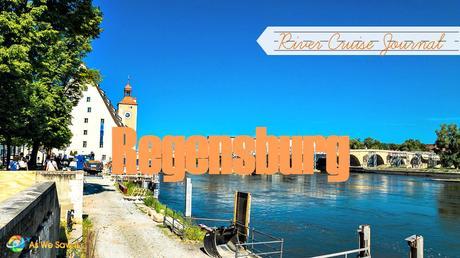
As we were about to discover, there’s a good reason that it’s a standard stop on every river cruise.
Which tour to take?
Bragi docked during breakfast but there was no rush to get off the boat: Our tours were scheduled to begin at 9:30. That gave us time to choose which tour to take. Viking offered three options:
- Walking tour of Regensburg
- Jewish heritage tour
- Church Architecture walk.
The standard walking tour was slated to run from 9:30-11:00 while the other two were slated to run until 11:30. Dan signed us up for the Jewish heritage tour because it was 30 minutes longer. Or so he said, wink-wink. I’m thinking that perhaps it’s because he wanted to be in a small tour group and church architecture isn’t his favorite subject.
Starting our tour
Our guide was a fascinating local who promised to show us Regensburg’s most notable sites on our tour as well as reveal the city’s Jewish heritage. It would be hard to do one without the other anyway. In the Middle Ages Regensburg had quite a large Jewish community, one that was essential to the city.
Actually the medieval Jewish quarter sat smack dab at the main intersection in the middle of the city until the Jews were kicked out in the Middle Ages. Considering their occupation their location is not surprising, I suppose. Because the Church had forbidden Christians from lending money and Jews were excluded from guild membership, the Jews naturally ended up doing all the money lending … and that’s where the whole “Jews and money” thing started. I hadn’t known that before, but it makes sense.
The stone bridge
Our walk to town began along the riverfront with a beautiful view of the city’s pride and joy: a historic stone bridge that was built in the 12th century. It was the only bridge across the river for more than 800 years, until another was built In the 1930s.
With its 16 stone arches, she said, it was an incredible piece of construction for that time period. It has seen a lot of traffic over the centuries and was doing fine until engineers determined that all the cars, trucks and buses were stressing the structure too much. So now it’s just a pedestrian bridge.
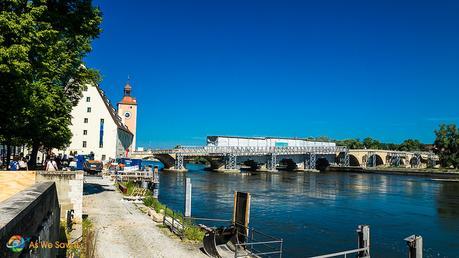
There’s an island in the middle of the river; that’s why you can’t see 16 arches in this photo.
At the far end of the stone bridge is Stadtamhof, an old town that has since been absorbed into Regensburg. It’s part of UNESCO’s heritage site area. I made a mental note to see it during our free time but got so engrossed in seeing the rest of Regensburg that I forgot to.
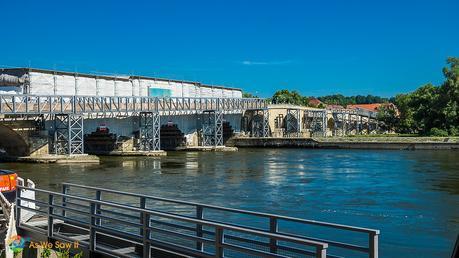
The bridge was undergoing a lot of restoration work while we were there.
Historiche Wurstkuche
As we approached the bridge we came to an ancient building called Historiche Wurstkuche. It is a 12th-century tavern and sausage kitchen—the oldest sausage kitchen in Europe—that still furnishes tourists and locals with beer and traditional sausages. I wonder how many sausages they have served and how many barrels of beer they have rolled through their doors over all that time.

Roman walls and gate
Although Regensburg is known as a well-preserved medieval city, it has actually been around since Roman times. Remnants of the original city wall and a gate are still standing. Still.
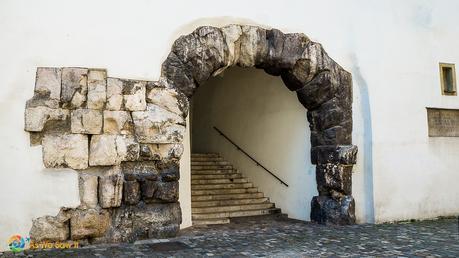
Yes, most of the city’s medieval center was spared from damage during World War II. The ancient bridge, on the other hand, was not so fortunate: As the Nazis retreated at the end of the war they blew up a part of the historic bridge to deter the Allies. I’m glad it was repairable.
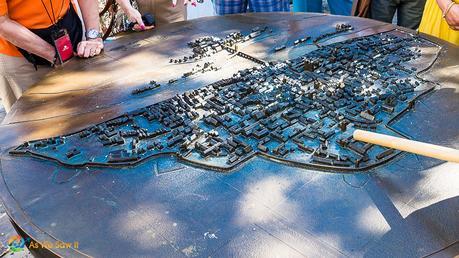
This is what medieval Regensburg looked like. You can see Stadthamhof on the other side of the bridge.
Altes Rathaus (city hall)
The Old Town Hall (Altes Rathaus) dates from the 14th century and has a remarkably large medieval courtroom. We arrived just as a wedding party was leaving the building. People who wish to get married make it legal at the city hall, then the next day they formalize it before God with a religious ceremony. (Germany does not recognize church weddings.)

Dom St. Peter (Regensburg’s cathedral)
Regensburg’s cathedral is a landmark in the city. Built in the 1300s it is one of the best examples of Gothic architecture in Bavaria.

Oskar Schindler’s former home
Of course our guide took us by the one-time residence of Oskar Schindler, who was immortalized in the movie “Schindler’s List.”
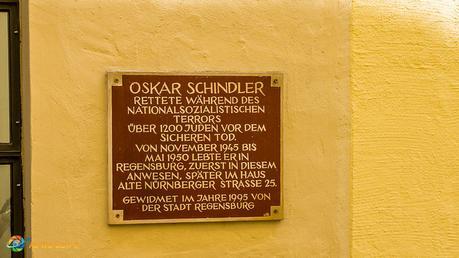
Site of the ancient synagogue
When the Jews were expelled in the Middle Ages their homes, businesses and synagogues were destroyed. A few years ago construction workers discovered remnants of the ancient community when they were clearing an area for a parking lot. As a tribute to that Jewish community the synagogue has been memorialized on its original foundation with a sculpture that artistically reproduces the layout of the original building.
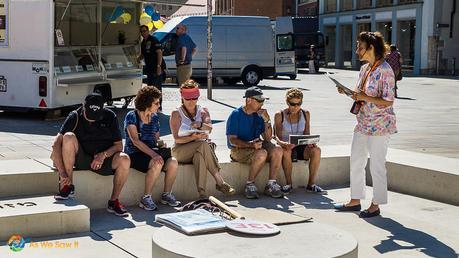
We sat around the sculpture as our guide showed us prints and photos and brought Regensburg’s Jewish history to life.
The artist envisioned a gathering place for people of all beliefs, with plenty of spots to relax and enjoy an ice cream or people watch. Where the Torah ark once stood, Hebrew characters now spell out the word “Misrach” (“place of lighting up”).
Stolpersteine
Then she invited us to follow her to a nearby corner so we could see an even more meaningful project: Stolpersteine (stumbling stones). These are small 10 cm-by-10 cm brass cobblestones in the sidewalks around the city that commemorate victims of National Socialism (Nazism). Each one is inscribed with the name of a person — Jewish, Roma, homosexual, disabled, etc. — who had his or her last address at this spot.
Our tour ended at Dom St Peter. Rather than return to the boat for lunch we decided to eat in town. We really wanted more time to wander and I wanted to see the inside of the Dom. Dan got some wonderful shots of Regensburg’s medieval center.
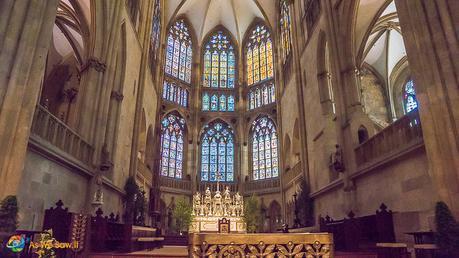
After salads at an Italian restaurant, two ice creams and a couple of espressos we returned to the boat, stopping at the bridge to visit the UNESCO center and museum and climb to the top of the clock tower for some beautiful views.

Bye-bye, Danube!
As we left Regensburg and set sail our cruise director Devi offered a presentation on the Main-Danube Canal, the next leg of our journey. Soon the Bragi would carry us across the continental divide of Europe and water would begin to flow toward the North Sea.
We spent the evening chatting with shipmates and dancing in the lounge.
Next stop: Nuremberg.
Want to see more photos from our day in Regensburg?
Enjoy them full-screen with our free Slideshow feature and pin your favorites.
- Click here to see more photos from our day in Regensburg Germany.
PIN TO PINTEREST! Click the button in the top left of our images to save them to your Pinterest galleries.
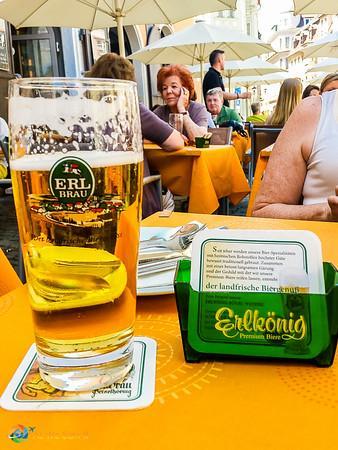
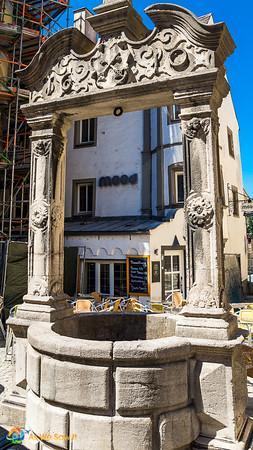
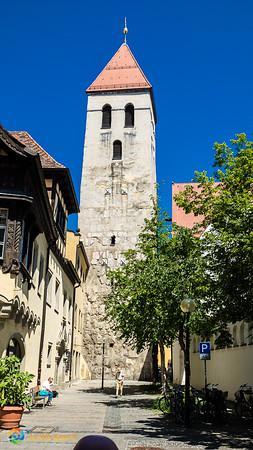
Read more …


Or just click here for the entire 15-day Viking Grand European tour itinerary. All of our cruise-related posts will end up on that page, so be sure to bookmark it!

